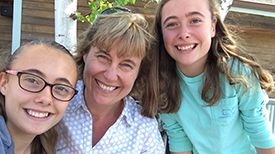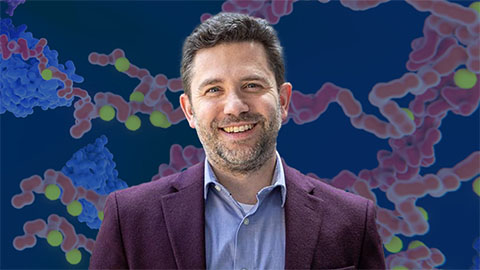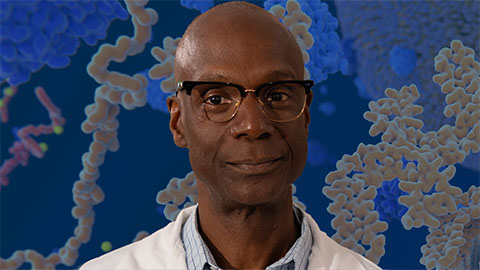‘Trust your own imagination’
Success in science comes when you stick with what you personally find most interesting, says Anna Marie Pyle. And she does as she says.
 Pyle
Pyle
Pyle, a faculty member at Yale University and a Howard Hughes Medical Institute investigator, has stuck with her fascination with RNA since she was a graduate student. During her graduate work with Jacqueline Barton, then at Columbia University, Pyle worked on DNA but became intrigued by ribozymes. To dive into the RNA world, Pyle took up a postdoctoral stint with Thomas Cech at the University of Colorado and then formed her own group focused on the structure and function of large RNA molecules and RNA-remodeling enzymes.
These days, members of the Pyle laboratory use biochemical, biophysical and computational techniques to understand the structures and functions of large RNA molecules and the enzymes that act upon them, such as RNA helicase enzymes and other RNA-stimulated ATPases that work as translocases, RNA remodeling enzymes, folding cofactors, and signaling enzymes.
How did you become interested in working with RNA?
When I was a graduate student, I was working on designing small molecules that would recognize sequences and features of double-stranded DNA. Around that time, the discovery of ribozymes was made. I got really excited about the potential for elaborate structure in RNA. So I decided that if I was interested in molecular recognition by nucleic acids, I should probably work on RNA. That’s when I contacted Tom Cech about working in his lab. I’ve been working on RNA ever since.
What does your lab focus on?
About half of the lab works on large, highly structured RNA molecules. Some are catalytic, and some are epigenetic control elements. The other half of the lab works on a very specialized class of motor proteins that are RNA-stimulated ATPases. They are important for remodeling RNA and some of them function as RNA-activated signaling enzymes. They all belong to the same phylogenetically conserved family.
Although most of the lab does experimental work, we do have a big computational contingent. We do a lot of development of new programs for modeling, analyzing and predicting RNA structures. We’ve had to develop tools to enable us to better solve structures.
 Pyle with her daughters. PHOTOS COURTESY OF ANNA MARIE PYLE
Pyle with her daughters. PHOTOS COURTESY OF ANNA MARIE PYLE
What triggered your interest in science in the first place?
I grew up surrounded by people who were interested in science in Albuquerque, N.M.. We did a lot playing around with rocks and minerals. We would go hiking. We also had elaborate chemistry sets, and we’d play with prisms. I was surrounded by a scientific mindset. To me, one of the things that is exciting about life is that physics and chemistry pervade everything.
But I didn’t commit to a scientific career early on. I went to a liberal arts institution – to Princeton (University). I studied a lot of different things, including public policy and Slavic languages. It wasn’t until very late in the game that I decided that I was going to get a Ph.D. in chemistry.
Were your parents scientists?
My dad was a cardiologist and a medical researcher. He also was involved in the space program and the military. But he was also a chemistry undergraduate, and he envied me going to graduate school instead of medical school! He got to enjoy it vicariously through me.
You mention your training in public policy and languages. Do you think that’s been important to you as a scientist?
It has. All of the education that I was fortunate enough to receive helped with my writing and communication skills. The fact that I was required to take a lot of history, language and literature has been a tremendous asset. I sometimes think that the time my favorite history professor, Dr. Arno Mayer, spent teaching me how to write a good paper was one of the most educationally important times in my life!
I suspected that one of the best ways to get involved in science policy was to become a strong scientist. That has turned out to be true. I decided that if I cared about science policy, I should get out there and understand how to do good science and make an impact scientifically.
What do you think are some of the big challenges in your area of research?
It’s become clear that we transcribe many large, functional RNA molecules that do not encode proteins. But we know very little about what they are doing. We have few phenotypes and functional readouts of their biological roles. Beginning to get a good intellectual handle on what all of these different noncoding RNAs actually are doing mechanistically is a huge challenge. A parallel challenge is to organize and draw mechanistic conclusions from the wealth of bioinformatic data that is emerging on noncoding RNAs. Another challenge is how to organize the mechanistic and structural information that is accumulating about RNA and RNA-binding proteins and leverage (the information) for small-molecule inhibitor and activator design. It’s a big frontier out there. A lot of these molecules are really interesting targets. It also would be great to bring together people who are trained classically in rigorous enzymology with projects that involve fascinating new enzyme families, such as those involved in epigenetic phenomena and signaling.
What advice would you give young scientists wanting to be successful in research?
The advice that I most frequently give is that you want to pick problems that you’re really passionate about. It should make you happy to know that you’re going into lab that day to work on that problem. That’s a very personal thing. There’s always a lot of pressure to work on what other people think is interesting. I think you have to reach inside yourself and determine what you find interesting. The rest really does follow if you’re doing something that makes you happy and is really exciting to you.
But I can’t underscore enough how personal that is. Students are constantly buffeted by trends. You really should decide what you personally find is interesting. In the beginning, other people may not see it the same way as you. But as my grad school advisor, Jackie Barton, used to tell me repeatedly, trust your own imagination to know why something is really significant and why you want to explore it.
Enjoy reading ASBMB Today?
Become a member to receive the print edition four times a year and the digital edition monthly.
Learn moreGet the latest from ASBMB Today
Enter your email address, and we’ll send you a weekly email with recent articles, interviews and more.
Latest in People
People highlights or most popular articles

Designing life’s building blocks with AI
Tanja Kortemme, a professor at the University of California, San Francisco, will discuss her research using computational biology to engineer proteins at the 2026 ASBMB Annual Meeting.

Jordahl named Gilliam Fellow
He will receive three years of funding to support his thesis research.

Bibel named assistant professor
She began her position at Loyola Marymount University in August 2025.

Unraveling the language of histones
Philip Cole presented his research on how posttranslational modifications to histones are involved in gene expression and how these modifications could be therapeutically targeted to treat diseases like cancer.

Cotruvo named Blavatnik award finalist
He received a $15,000 prize and was honored at a gala in October.

Phosphatases and pupils: A dual legacy
Yale professor Anton Bennett explores how protein tyrosine phosphatases shape disease, while building a legacy of mentorship that expands opportunity and fuels discovery in biochemistry and molecular biology.

